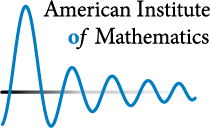1. Galois groups acting on trees
-
Fixed point proportion of dynamical exceptional polynomials
Let $G$ be a group acting on a infinite rooted tree, and denote $G_n$ the action of $G$ on the first $n$ levels of the tree. We define the fixed-point proportion of $G$ as $$FPP(G) = \lim_{n \rightarrow +\infty} \frac{\# \left\{g \in G_n: \text{ $g$ fixes at least one element on level $n$}\right\}}{\# G_n}.$$
Let $k$ be a field, $f \in k(z)$ of degree at least $2$, and $t \in k$. Define $k_n = k(f^{-n}(t))$, $G_n = Gal(k_n/k(t))$ and $G_\infty = \varprojlim G_n$. The group $G_n$ acts on $f^{-n}(t)$ via the natural action of the Galois group, so $G_\infty$ acts on the infinite rooted tree of the $n$-th preimages of $t$ via $f$. \\
In particular, if $k = \mathbb{C}(t)$ with $t$ transcendental over $\mathbb{C}$, $G_\infty$ is isomorphic to the closure of the iterated monodromy group of $f$, denoted $IMG(f)$ (see Proposition 6.4.2 in [MR2162164]). Results in this direction can be found in [arXiv:1204.2843], where it is proved that for non dynamically exceptional rational functions, $FPP(IMG(f)) = 0$.
Let $k$ be a field, $f \in k(z)$ of degree at least $2$, and $t \in k$. Define $k_n = k(f^{-n}(t))$, $G_n = Gal(k_n/k(t))$ and $G_\infty = \varprojlim G_n$. The group $G_n$ acts on $f^{-n}(t)$ via the natural action of the Galois group, so $G_\infty$ acts on the infinite rooted tree of the $n$-th preimages of $t$ via $f$.Problem 1.1.
[Santiago Radi] 1. What can we say about the fixed-point proportion of groups acting on rooted trees?
2. Fixing the tree $T$, can we find a family of groups such that its fixed-point proportion is nonzero and its Hausdorff dimension converges to $1$?
3. What can we say about the fixed-point proportion of Galois groups?
4. What can we say about the fixed-point proportion of $IMG(f)$ of complex rational functions?
5. What can we say about the fixed-point proportion of $IMG(f)$ of complex polynomials that are not dynamically exceptional? -
Analogous of paths on iterated monodromy groups for iterated Galois groups of dynamical maps
Let $k$ be a field, $f \in k(z)$ of degree at least $2$, and $t$ be a transcendental number. Define $k_\infty = k \left( \cup_{n \geq 0} f^{-n}(t) \right)$, $L = k_\infty \cap \overline{k}$, $G_\infty = Gal(k_\infty/k(t))$ and $G_\infty^{geom} = Gal(k_\infty/L(t))$. \\
It was proved by Richard Pink (see \cite[Proposition 6.4.2]{Self_similar_groups}) that when $k = \mathbb{C}$, then $G_\infty^{geom} = \overline{IMG(f)}$ and for the iterated monodromy group of a continuous covering map, there is an explicit way to construct it by choosing paths between the chosen base point $z_0$ and $f^{-1}(z_0)$. \\
Following the analogous of $IMG(f)$, we know the iterated monodromy group of $f$ can reconstruct the Julia set of $f$.Presently, we can only get wreath recursions up to conjugacy by algebraic methods, and Pink shows that for quadratic PCF polynomials these choices do not matter. We cannot expect to easily obtain "nice" paths in general, because this would be significant progress toward calculating the ’etale fundamental group of punctured $\mathbb{P}_{\bar K}^1$ in purely algebraic terms, a problem which has been open for decades. This is why a recursive description is expected at best, something highly dependent on the structure of $K_\infty$.Problem 1.2.
[Ophelia Adams] 1. Can we algebraically construct "nice" paths to describe $G_\infty^{geom}$ by more explicit wreath recursions? More precisely, given $z\in f^{-1}(t)$, can we find explicit endomorphisms of $K_\infty$, perhaps recursively described, sending $t$ to $z$ with nice properties? -
Wreath recursion for Galois groups
Problem 1.3.
1. Contruct explicit wreath recursions for Galois groups
2. Under what conditions is a group coming from a Galois arboreal representation a branch group? -
Reconstructing the Julia set of a function from the iterated Galois group
Let $k$ be a finite field extension of $\mathbb{Q}_p$, $f \in k(z)$ of degree at least $2$, and $t$ be a transcendental number. Define $k_\infty = k \left( \cup_{n \geq 0} f^{-n}(t) \right)$, $L = k_\infty \cap \overline{k}$, $G_\infty = Gal(k_\infty/k(t))$ and $G_\infty^{geom} = Gal(k_\infty/L(t))$. \\Problem 1.4.
[Ophelia Adams] Can we reconstruct the $p$-adic Julia set of $f$ from $G_\infty$ or $G_\infty^{geom}$ -
Orbit equivalence for IMG
Let $G,H$ two groups acting on the same set $X$. We say that $G$ and $H$ are orbit equivalent if they have the same orbits. \\
Let $f$ be a continuous map and $IMG(f)$ its iterated monodromy group. Assume $IMG(f)$ is countable and consider its action on $\partial T$, the boundary of the tree. \\A result in this direction is [MR2563761] where it is proved $\rho$ is an action of $\mathbb{Z}^d$ over a Cantor set that is free and minimal, then $\rho$ is orbit equivalent to an action of $\mathbb{Z}$ over the same Cantor set that is also free and minimal.Problem 1.5.
[Constantine Medynets] 1. Can we find $\varphi \in Homeo(\partial T)$ such that the orbit of the group generated by $\varphi$ and $IMG(f)$ are orbit equivalent?
2. Can we make $\varphi$ explicit?
Cite this as: AimPL: Groups of dynamical origin, available at http://aimpl.org/groupdynamorigin.
